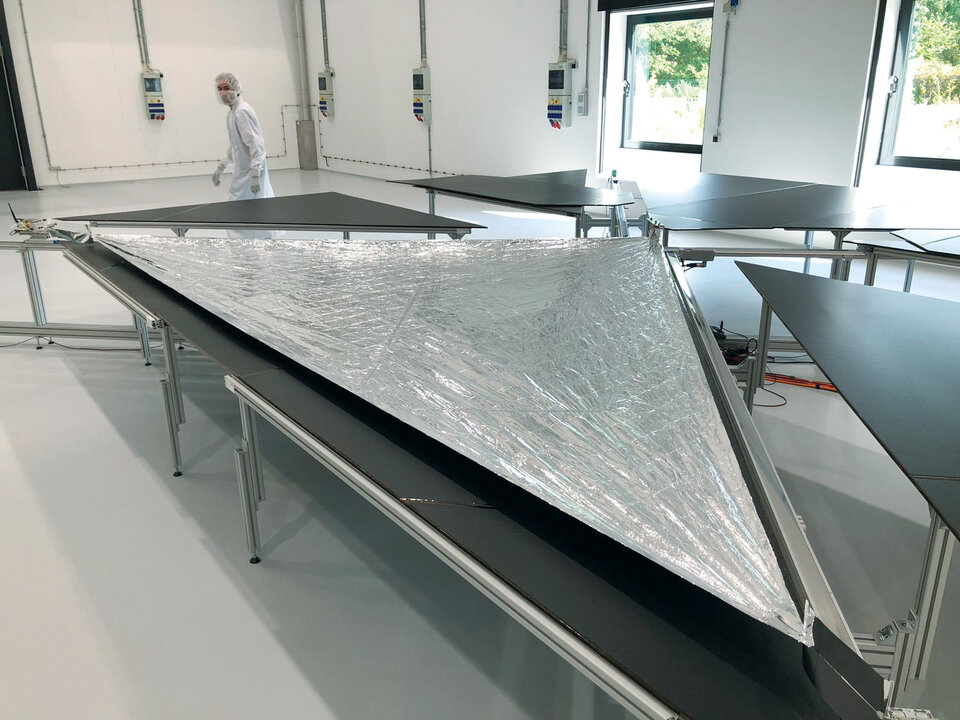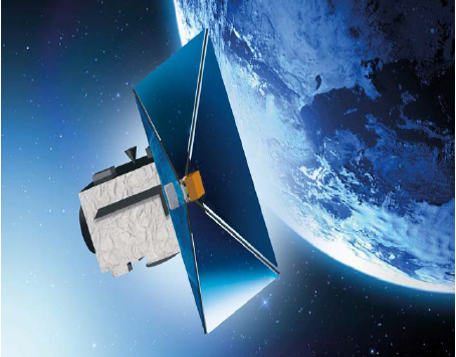Space is getting crowded. Old satellites, failed spacecraft and debris are crowding orbit. This space junk means there is little space for new satellites and that the risk of collision in space is high.
The space debris environment, especially in low earth orbit (LEO), is an increasing risk for all spaceflight missions and ESA is already pioneering an eco-friendly approach to space activities. On the ground, that means adopting greener materials, processes and technologies. But in space it means preserving Earth’s orbital environment as a safe zone, free of debris.
One of the ways the space industry aims to solve the debris problem is through de-orbiting – pushing this junk out of orbit and into the Earth’s atmosphere where it can burn up. The most common approach, is to opt for a controlled re-entry. This solution is quite heavy and expensive, as it requires additional fuel. Other spacecraft use de-orbit subsystems. Currently most of these are clunky, weigh too much and need their own guidance and navigation system to make sure the space craft leaves orbit safely.

But an ongoing activity with ESA’s General Support Technology Programme (GSTP) and HPS, Germany, intends to change that. The activity is developing a subsystem that will recognise as soon as the satellite has come to the end of its mission or has failed, for example if it has had no signal for a month. It will then slowly unfurl a large aluminium-coated polyamide membrane, attached to four carbon-fibre reinforced booms. This membrane acts as a sail, to create a drag effect causing the spacecraft to decrease its orbit much faster, catching at the atmosphere to slow the worn-out spacecraft enough that it will burn up entirely. A process that can take quite long, depending on the spacecraft – up to 25 years.
Originally proposed in 2012, based on previous developments by DLR, the German space agency, the activity planned to build a passive de-orbit subsystem that held to just a few strict limitations. The system had to be extremely light, it had to be scalable so that it could be used on a variety of different spacecraft and it needed to be entirely passive – meaning no control system was needed.
In 2017, the first iteration of this subsystem, ADEO, was completed and survived extensive environmental tests. Since 2018, a consortium of twelve partners (including many small and medium-sized enterprises) have been working on ADEO-2.

At just 3.5 per cent of the spacecraft’s entire mass, ADEO-2 can be scaled up or down to meet requirements but will always be very light and cost-effective compared with the fuel needed for a controlled deorbit manoeuvre. Although at the end of the mission, or after a failure, the spacecraft can be tumbling, several aerothermodynamic calculations have shown that it is safe to deploy the sail and that the satellite will slowly self stabilise, without any need for an expensive guidance, navigation and control system added. Another advantage is that the entire subsystem, especially the sail membrane, burns up very easily on re-entry into the atmosphere.
The sail can work even if the satellite is completely unresponsive. If the satellite has functional problems then this subsystem can detect it and deploy the sail autonomously, starting the process of deorbiting.
Right now, the activity has started to build a prototype flight model sail of 25m2, which would be suitable for a spacecraft of around 700kg.
So far, a small version of ADEO (named ADEO-N) has already flown on the upper stage of the New Zealand launcher, Electron, and the sail was successfully deployed and deorbit achieved.The activity plans to be tested on ground by the beginning of 2021 and has already been committed to an in orbit verification flight on an EU mission next year.
Eventually, the activity plans to be used across thousands of spacecraft, from small cubesats to entire constellations, without the capacity for an active or controlled re-entry system, to help ensure that orbit can be a safe and useable place for many generations to come.














110 comments
Hiya, I am really glad I have found this info. Today bloggers publish just about gossips and web and this is actually annoying. A good blog with exciting content, that’s what I need. Thank you for keeping this site, I’ll be visiting it. Do you do newsletters? Can’t find it.
hello there and thanks on your information – I have certainly picked up something new from right here. I did on the other hand expertise several technical issues using this site, since I skilled to reload the site a lot of times prior to I may just get it to load correctly. I were wondering in case your web hosting is OK? No longer that I’m complaining, but slow loading circumstances times will often have an effect on your placement in google and can injury your high quality ranking if ads and ***********|advertising|advertising|advertising and *********** with Adwords. Anyway I am adding this RSS to my e-mail and can look out for a lot extra of your respective intriguing content. Make sure you update this again very soon..
I know this if off topic but I’m looking into starting my own weblog and was curious what all is required to get set up? I’m assuming having a blog like yours would cost a pretty penny? I’m not very web savvy so I’m not 100 sure. Any suggestions or advice would be greatly appreciated. Many thanks
Rattling superb info can be found on blog. “Even if happiness forgets you a little bit, never completely forget about it.” by Donald Robert Perry Marquis.
Heya i am for the first time here. I found this board and I find It really useful & it helped me out a lot. I hope to give something back and aid others like you aided me.
You can definitely see your skills within the paintings you write. The arena hopes for even more passionate writers like you who aren’t afraid to mention how they believe. All the time follow your heart.
I’m curious to find out what blog system you happen to be using? I’m experiencing some small security issues with my latest website and I would like to find something more safeguarded. Do you have any suggestions?
Thanks, I have just been looking for info about this topic for a while and yours is the best I have discovered so far. But, what about the bottom line? Are you positive about the source?
I’m really enjoying the design and layout of your website. It’s a very easy on the eyes which makes it much more pleasant for me to come here and visit more often. Did you hire out a developer to create your theme? Excellent work!
Hiya very nice blog!! Man .. Beautiful .. Amazing .. I’ll bookmark your website and take the feeds additionally?KI am satisfied to seek out a lot of useful info right here in the submit, we need develop more techniques in this regard, thank you for sharing. . . . . .
An impressive share, I just given this onto a colleague who was doing a little analysis on this. And he in fact bought me breakfast because I found it for him.. smile. So let me reword that: Thnx for the treat! But yeah Thnkx for spending the time to discuss this, I feel strongly about it and love reading more on this topic. If possible, as you become expertise, would you mind updating your blog with more details? It is highly helpful for me. Big thumb up for this blog post!
I was curious if you ever considered changing the structure of your website? Its very well written; I love what youve got to say. But maybe you could a little more in the way of content so people could connect with it better. Youve got an awful lot of text for only having one or 2 images. Maybe you could space it out better?
площадка для продажи аккаунтов купить аккаунт с прокачкой
продажа аккаунтов профиль с подписчиками
маркетплейс аккаунтов маркетплейс аккаунтов соцсетей
Account exchange Account Catalog
Buy accounts Sell Account
Website for Selling Accounts Account exchange
Account Sale Accounts market
Marketplace for Ready-Made Accounts Buy and Sell Accounts
Buy and Sell Accounts Buy accounts
Accounts market Secure Account Purchasing Platform
Database of Accounts for Sale Find Accounts for Sale
Account Trading Service Account Trading Platform
Social media account marketplace Accounts for Sale
find accounts for sale https://cheapaccountsmarket.com
gaming account marketplace account market
account market sell accounts
account trading platform ready-made accounts for sale
account trading service website for buying accounts
buy and sell accounts account exchange service
secure account sales https://accountsmarketdiscount.com/
secure account purchasing platform account buying platform
marketplace for ready-made accounts online account store
secure account purchasing platform account market
Really nice layout and excellent content, absolutely nothing else we want : D.
account market buy-soc-accounts.org
account sale sell accounts
profitable account sales accounts marketplace
account exchange service accounts market
sell accounts accounts marketplace
sell pre-made account account marketplace
account trading platform buy account
marketplace for ready-made accounts database of accounts for sale
I always was concerned in this subject and still am, thanks for putting up.
account trading platform accounts marketplace
account market https://accounts-market-soc.org/
sell accounts ready-made accounts for sale
sell accounts ready-made accounts for sale
verified accounts for sale website for selling accounts
online account store website for buying accounts
account sale purchase ready-made accounts
account acquisition https://accounts-marketplace.xyz/
account exchange service https://buy-best-accounts.org
verified accounts for sale https://social-accounts-marketplaces.live/
account selling platform accounts-marketplace.live
profitable account sales https://social-accounts-marketplace.xyz
account marketplace https://buy-accounts.space/
secure account purchasing platform https://buy-accounts-shop.pro
sell accounts https://accounts-marketplace.art
account market accounts market
account market https://buy-accounts.live
verified accounts for sale https://accounts-marketplace.online/
account market https://accounts-marketplace-best.pro
продать аккаунт https://rynok-akkauntov.top/
магазин аккаунтов kupit-akkaunt.xyz
маркетплейс аккаунтов https://akkaunt-magazin.online
площадка для продажи аккаунтов https://akkaunty-market.live/
продать аккаунт https://kupit-akkaunty-market.xyz/
биржа аккаунтов akkaunty-optom.live
площадка для продажи аккаунтов маркетплейсов аккаунтов
продать аккаунт https://kupit-akkaunt.online/
buy old facebook account for ads buy facebook ads account
buy a facebook ad account facebook ad accounts for sale
buy facebook accounts for ads https://buy-ads-account.click
facebook ad account for sale https://ad-account-buy.top
buying facebook account https://buy-ads-account.work
facebook account buy ad-account-for-sale.top
buy old facebook account for ads https://buy-ad-account.click
buy accounts facebook https://ad-accounts-for-sale.work
google ads agency account buy https://buy-ads-account.top
google ads reseller https://buy-ads-accounts.click
facebook accounts to buy https://buy-accounts.click
buy aged google ads accounts https://ads-account-for-sale.top
buy google ads invoice account buy adwords account
google ads reseller https://buy-account-ads.work
google ads account for sale buy-ads-agency-account.top
old google ads account for sale google ads account seller
buy google agency account https://ads-agency-account-buy.click
buy bm facebook https://buy-business-manager-acc.org
buy facebook ads accounts and business managers https://buy-bm-account.org/
buy facebook business account buy-verified-business-manager-account.org
buy verified facebook business manager account https://buy-verified-business-manager.org/
buy facebook business manager business-manager-for-sale.org
buy facebook bm buy-business-manager-verified.org
facebook verified business manager for sale verified-business-manager-for-sale.org
verified bm for sale https://buy-business-manager-accounts.org
tiktok ads agency account https://buy-tiktok-ads-account.org
tiktok agency account for sale https://tiktok-ads-account-buy.org
tiktok ads agency account https://tiktok-ads-account-for-sale.org
buy tiktok ad account https://buy-tiktok-ad-account.org
buy tiktok business account https://buy-tiktok-ads-accounts.org
tiktok agency account for sale https://buy-tiktok-ads.org
buy tiktok ads accounts https://tiktok-ads-agency-account.org
Hiya very cool blog!! Man .. Excellent .. Amazing .. I will bookmark your site and take the feeds alsoKI am satisfied to find a lot of helpful information here within the submit, we want work out extra techniques on this regard, thanks for sharing. . . . . .
It?¦s really a great and useful piece of info. I?¦m glad that you simply shared this helpful info with us. Please stay us up to date like this. Thank you for sharing.
where can i buy cheap clomiphene tablets clomiphene only cycle can you buy cheap clomiphene without a prescription cost cheap clomid without insurance where can i buy generic clomiphene how to buy clomiphene without dr prescription clomiphene costo
Aw, this was a really nice post. In concept I wish to put in writing like this moreover – taking time and precise effort to make an excellent article… however what can I say… I procrastinate alot and in no way seem to get something done.
You have brought up a very good points, thanks for the post.
You are my inspiration , I possess few web logs and rarely run out from to brand.